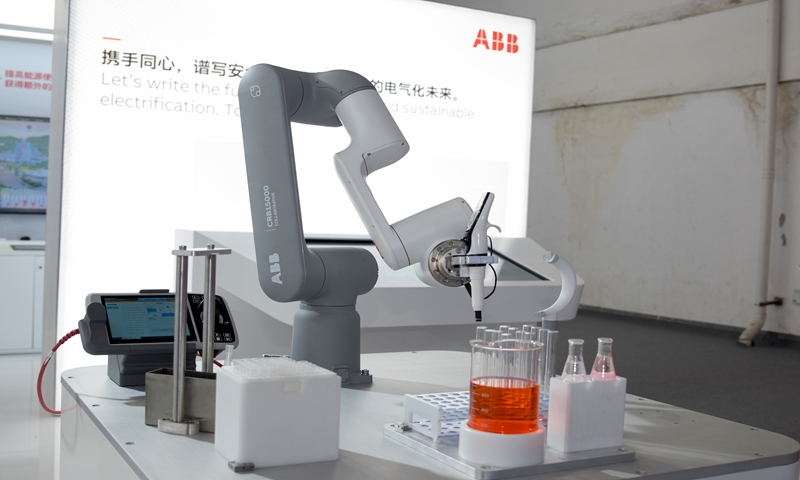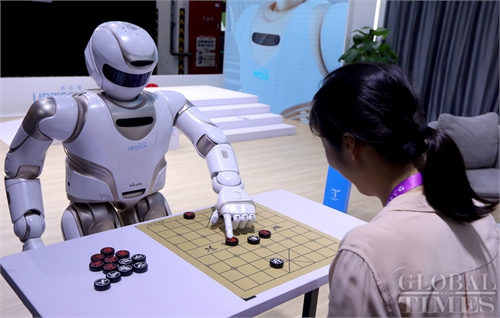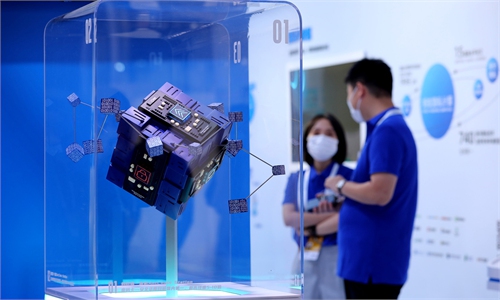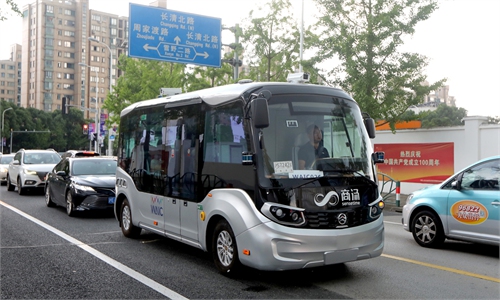Global tech firms eye opportunities under China's carbon goals
Foreign firms showcase technologies with an eye on $2.3t market

A robotic arm of ABB is showcased at the 2021 World Artificial Intelligence Conference on July 7, 2021. Photo: VCG
The World Artificial Intelligence Conference (WAIC) is a platform for global tech giants to showcase their latest cutting-edge artificial intelligence (AI) and other technologies, but at this year's event that concluded on Saturday, a new theme emerges among foreign companies: potential opportunities under China's bold goals to cut carbon emissions.
At the three-day conference, a number of exhibitors showcased their latest robotics and AI technologies that they argue could help China reach its goal of hitting carbon emissions peak by 2030 and realizing carbon neutrality by 2060.
Behind their renewed focus is a massive market for everything from robots to AI technologies. According to a report by the Investment Association of China and Rocky Mountain Institute, China's de-carbonization will create a market of 15 trillion yuan ($2.3 trillion) by 2050, especially in the resource recycling, energy efficiency, demand side electrification, zero-carbon power generation, energy storage, hydrogen and digitalization.
Intelligent technologies
At the 2021 WAIC in Shanghai, Schneider Electric, a global energy and automation digital solutions provider, introduced its Advanced Process Control (APC) system designed to reduce operation energy consumption and the labor intensity.
When applied to a cement production line with an annual cement clinker output of 3.2 million tons, the system could help reduce the standard coal consumption by 2.44 kilograms, or 1.87 percent, the annual carbon dioxide emission by 8,400 tons, and the annual energy cost by 3.2 million yuan, according to the company.
As the digital transformation deepens, AI, Internet of things, cloud computing and other emerging technologies will undoubtedly become the first choice to achieve green and sustainable development in the approach of carbon neutrality, Xiong Yi, senior vice president for strategy and business development at Schneider Electric China, said in a speech during the WAIC.
Over the past three years, the overall energy consumption of Schneider Chinese plants has decreased by 12.4 percent, while the production efficiency has increased by 5 percent, according to Schneider.
Industrial robot supplier and manufacturer ABB Robotics is also among the foreign businesses harnessing the power of robotics and AI to unlock sustainable growth in new sectors of the Chinese economy.
ABB showcased an innovative painting solution called PixelPaint at the WAIC. Launched last year, it ensures that 100 percent of the paint will be applied to the bodywork surface with no overspray whereas traditionally 30 percent of paint is wasted.
The technology has already been applied in a manufacturing plant of Chinese electric vehicle maker XPeng, which is able to increase the painting rate by about 10 percent and reduce the energy consumption by 25 percent.
"Today, China has become a global driving force in robotics and automation. The promotion of new economic development models and new infrastructure in China has enabled us to explore new opportunities in many industries, such as new energy vehicles, 5G and consumer electronics and logistics," said Sami Atiya, president of ABB Robotics & Discrete Automation, in a statement sent to the Global Times.
As more and more robots are used across the economy, recycling and making the best use of the older models has also become a problem facing the companies. A remanufacturing service at ABB is able to allow existing robot users to sell inactive robots to ABB with an attractive buy back service, rather than scrapping them or leaving them unused.
Over the last 25 years, thousands of robots have been refurbished and upgraded by ABB's remanufactured robot teams to give them a second life, according to Atiya.
De-carbonization market
According to statistics published by Boston Consulting, the application of AI is expected to reduce at least 2.6-5.3 billion tons of carbon dioxide emissions by 2030, and create more than $1.3 trillion in value for enterprises.
Over the next 10 years, China would see two trillion yuan of capital in the investment market driven by AI powered carbon neutralization, Peng Hu, executive general manager of research department of China International Capital Corp (CICC), said at an investment and financing forum at the WAIC.
China's carbon emissions reduction plan is of great interest to overseas companies as it could help unlock a massive market with huge profit potential, Lin Boqiang, director of the China Center for Energy Economics Research at Xiamen University, told the Global Times on Sunday.
"China welcomes the participation of global enterprises to engage in the goal of carbon neutrality. As long as they want to be a part of the market, it could bring ample profits from the business," Lin said.
He also stressed that most players in China's carbon market will still be domestic companies but certain overseas companies with technological prowess might stand out, noting that the improvement of energy supply efficiency powered by AI will become the next focus of industry transformation.
It is expected the improvement in renewable electricity generation will reduce more than 60 billion kilograms of carbon dioxide emissions annually in the future, per CICC.



